X-Woman Discovered: Is She Yeti? Almas? What?
Posted by: Loren Coleman on March 25th, 2010
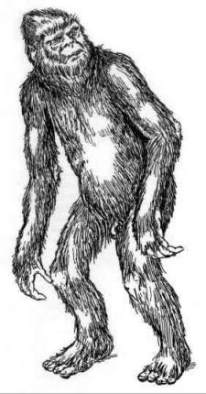
The reported appearance of an Almas? Now as then?
Exciting news is all over the media of the remarkable announcement of a fourth form of hominid being discovered. This new hominin – being called everything from “X-Woman,” to less often, “Digit,” although “Denisova hominin” may end up the name of choice – is said to have lived at the same time (40,000+/- years b.p.) as humans (Homo sapiens), Neandertals (Homo neanderthalensis) and hobbits (Homo floresiensis).
In the current issue of Nature, Johannes Krause and his colleagues (J.M, Good, B. Viola, M.V. Shunkov, A.P. Derevianko, and S. Sääbo) announced the complete mitochondrial sequence of a pinky bone from Denisova Cave, in the Altai Mountains of Siberia, goes far in proving it was much different than anything recognized before. These researchers estimate the age of the little finger (digitus mínimus mánus or pinky) to be between 30,000 and 48,000 years old, living at a time when it is known that both Neanderthals and anatomically modern humans also lived in that region of southern Siberia.
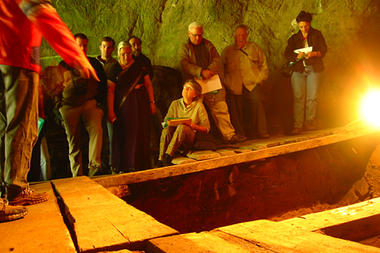
Participants in a 2005 archaeological conference crowd into Denisova cave in the Altai Mountains of Siberia. A pinky bone found later in the cave now points to what could be a new human relative, distinctly different from Neanderthals or modern humans. Researchers call this potential form of hominin, “X Woman.” Photo: Johannes Krause.
“This was absolutely amazing,” says team member Svante Paabo, with the Max Planck Institute for Evolutionary Anthropology in Leipzig. Whoever this was that left “Africa 1 million years ago is some new creature that has not been on our radar screen so far.”
Ian Tattersall of the American Museum of Natural History in New York was quoted as observing, regarding the new discovery: “The human family tree has got a lot of branchings. It’s entirely plausible there are a lot of branches out there we don’t know about.”
Three human-sized hominids, plus a group of little people, inhabited the planet, humm?
“Forty thousand years ago, the planet was more crowded than we thought,” said Terence Brown of the University of Manchester.
Of course, cryptozoologists and hominologists had figured this out years ago. We also wonder if it continues to be so.
We are not alone. If there is any truth to the testimony of eyewitnesses worldwide, we appear to live amidst a variety of humanlike and apelike creatures whose existence has been largely ignored, forgotten, or denied, at least in recent history. Despite the crowding of the earth’s surface with our species, and the encroachment by Homo sapiens into the mountains, wildernesses, and wild places around the world, there is apparently ample room left over for our elusive cousins to hide. And they have done just that–for the most part. But as the reports of encounters accumulate, it has become increasingly clear that an understanding of these creatures lies not in myth, folklore, and legend, but ultimately, in reality. Loren Coleman and Patrick Huyghe, The Field Guide to Bigfoot and Other Mystery Primates (NY: Anomalist Books, 2006; as originally written in the first edition, NY: HarperCollins, 1999)
John Hawks Weblog, an outstanding site filled with his down-to-earth thoughts on any new paleoanthropology discovery, correctly notes that the new Denisova hominin, while it certainly is a “new form” of hominid, has hardly been declared full species status yet. After all, we are dealing with a pinky only, here.
John Hawks then states outloud what many of us are thinking: “One of my long-time correspondents is already calling it ‘the Yeti.'” And ending with this: “Maybe it’s a Yeti after all.”
Hawks’ correspondent might have the right idea, but these folks are using the wrong name. As I and others have written about, what we would project finding in the Denisova cave area of the Altai Mountains of Siberia and Mongolia, especially, if they remained in the area, would be Almas, Chuchunaa, and Mulen, all different localized names for unknown hairy hominins. In recent years, Almas, Chuchunaa, and Mulen would have been casually (and perhaps a bit incorrectly) called “Yetis,” or even “Siberian Snowmen.”
Some interesting indications of an unknown hominin have surfaced in the cryptozoological records for years, specifically, in south Siberia and Mongolia.
“Almas” is a Mongolian (Altaic) term for “wild man,” reported from Central Asia. “Chuchunaa” is related to the Yakut (Turkic) word for “fugitive” or “outcast,” and is said to be a giant hominid of eastern Siberia. The related form “Mulen” is an Evenki/Altaic term with origins in the word “bandit,” and also used to describe unknown, hairy bipeds from eastern Siberia.

Almas in motion, by Richard Klyver.
There is a long history of sightings of Almas and kin for this area.
Bavarian soldier Johannes Schiltberger, who was captured by the Turks in 1402 and sent to Mongol, while in the Tian Shan Mountains, became the first Westerner to see Almas. He reported two had been caught in the mountains, and were covered with hair except for their hands and faces.
As recently as 1963, Russian pediatrician Ivan Ivlov was traveling in the Altai Mountains of western Mongolia when he saw a male, a female, and a young Almas on a mountain slope. He observed them through binoculars at a distance of about a mile until they moved out of sight. Afterwards, he queried a number of his patients about the Almas and obtained some detailed stories.
Many Mulen reportedly were killed during the Russian Civil War, 1918–1921, when refugees moved into previously uninhabited areas.
In the 1920s, Tatyana Zakharova and other Evenk villagers came across a Chuchunaa while gathering berries near Khoboyuto Creek. It was also picking and eating berries, but it stood up to a full height of nearly 7 feet when it saw them and ran away swiftly. The Chuchunaa was dressed in deerskin, had long arms, a small forehead, and jutting chin. In Czarist times and during World War II, many Chuchunaa were said to have been rounded up and killed, their corpses buried secretly.
Myra Shackley in her book, Still Living? Yeti, Sasquatch and the Neanderthal Enigma (New York: Thames and Hudson, 1983), remarkably proposed the theory (almost 30 years ago) that the Chuchunaa and Mulen might be associated with the nearby fossil finds of some ambiguous teeth found in the Middle Paleolithic layers of Denisova cave in the Altai Mountains bordering Kazakhstan. Today, we understand this to be the same location for the X-Woman or the Denisova hominin.
Others have written about the affinities of the unknown hairy hominids in this part of the world, including many notables in cryptozoology/hominology, namely, Ivan T. Sanderson, B. Rinchen, P. L. Dravert, Vladimir Pushkarev, Gavriil V. Ksenofontov, Dmitri Bayanov, Boris A. Porshnev, Bernard Heuvelmans, Odette Tchernine, Michael Heaney, Chris Stringer, Ra Rabjir, Patrick Huyghe, Mark A. Hall, and Loren Coleman.
The discovery of the Denisova hominin, I encourage, should cause anthropologists to reexamine some of these stories. It has happened before.
In 2003-2004, when the discovery of the hobbits, lest we forget that between nine and eleven Homo floresiensis have been found, was announced, the tales and folklore of the island of Flores’ little ebu gogo were gathered and said to relate to the find of the little woman of Flores. Now the world is being introduced to the “X-Woman,” which actually seems to be a young female. We expect that the jokes about “Yetis” might abound. They should not hide the reality that there might be a link between the stories of Almas, Chuchunaa and Mulen and the X-Woman’s population.
Serious scientists have been open-minded in the past. And others will be tomorrow.
“The discovery that Homo floresiensis survived until so very recently, in geological terms, makes it more likely that stories of other mythical, human-like creatures such as Yetis are founded on grains of truth….Now, cryptozoology, the study of such fabulous creatures, can come in from the cold.”
~ Henry Gee, editor of Nature, in his “Flores, God and Cryptozoology,” 2004 editorial.
Mecheny (which may be yet another local name for a Chuchunaa), is here shown as drawn by artist Harry Trumbore in The Field Guide to Bigfoot and Other Mystery Primates.
What did the X-Woman look like? Let’s hope the drawings of the X-Woman will, at least, show a woman. But then again, all that has been found is a pinky, we must remember.
I am reminded of a scene from the 1999 film, Lake Placid. Upon finding a small digit from the otherwise missing body of a deputy, who was a victim of the alligator in the lake, a scientist hands it to the local law enforcement representative:
Hector: Is this the man that was killed?
Sheriff Hank Keough: He seemed…taller.

The original drawing after the first hobbit was announced, the one of LB1, as seen in the above National Geographic painting, showed the first Homo foresiensis find as a male. This is to be compared to Richard Klyver’s sketch of the Flores woman. The first fossil discovery of Homo floresiensis was of a female, not a male, of course.
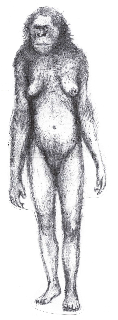
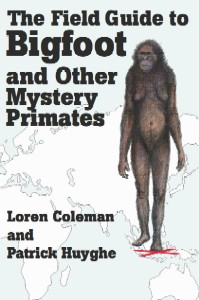
The Little Lady of Flores is on the front cover of The Field Guide to Bigfoot and Other Mystery Primates , illustrated with a drawing of Homo floresiensis by wildlife artist Richard Klyver.
Speculations and discoveries will continue to change the landscape of human evolution.
Books continue to be revised. We only have to reflect that it was in 2007, when it was announced, that in 2000, Richard Leakey found an ancient complete skull of Homo erectus. It had been discovered within walking distance of an upper jaw of a Homo habilis, and both dated from the same general time period. A new study a mere three years ago said it was unlikely that H. erectus evolved from H. habilis and the below graphic was produced. It will have to be revised again.
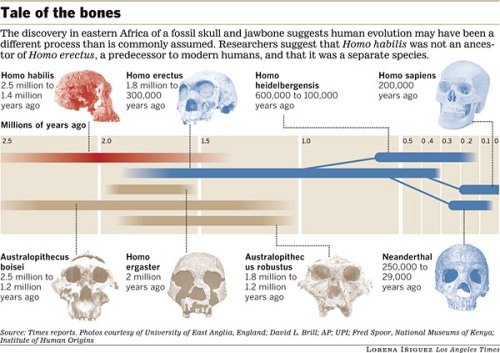
And so it goes.
+++
The image at the top of this blog posting is Harry Trumbore’s drawing of an Almas, from The Field Guide to Bigfoot and Other Mystery Primates.
+++
ICM Moment
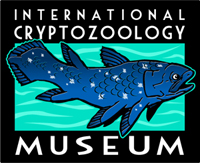
When visiting the International Cryptozoology Museum in Portland, Maine, be certain to view the first replica of the Homo floresiensis skull to have been obtained and displayed in North America after the 2003 discovery of the Little Lady of Flores. The ICM also has full-scale museum-quality busts of Paranthropus (“Nutcracker Man”) and Australopithecus afarensis (“Lucy”), plus Dr. Grover Krantz’s full-sized recreations of the skulls of Gigantopithecus and his rare Meganthropus reconstruction (the last one he did just before he passed away).
The International Cryptozoology Museum™ leads the way in being your gateway to adventure, education and discovery.
About Loren Coleman
Loren Coleman is one of the world’s leading cryptozoologists, some say “the” leading living cryptozoologist. Certainly, he is acknowledged as the current living American researcher and writer who has most popularized cryptozoology in the late 20th and early 21st centuries.
Starting his fieldwork and investigations in 1960, after traveling and trekking extensively in pursuit of cryptozoological mysteries, Coleman began writing to share his experiences in 1969. An honorary member of Ivan T. Sanderson’s Society for the Investigation of the Unexplained in the 1970s, Coleman has been bestowed with similar honorary memberships of the North Idaho College Cryptozoology Club in 1983, and in subsequent years, that of the British Columbia Scientific Cryptozoology Club, CryptoSafari International, and other international organizations. He was also a Life Member and Benefactor of the International Society of Cryptozoology (now-defunct).
Loren Coleman’s daily blog, as a member of the Cryptomundo Team, served as an ongoing avenue of communication for the ever-growing body of cryptozoo news from 2005 through 2013. He returned as an infrequent contributor beginning Halloween week of 2015.
Coleman is the founder in 2003, and current director of the International Cryptozoology Museum in Portland, Maine.










A pinky isn’t going to give you body morphology or degree of hirsuteness, nor is mDNA. That is all we have of this individual.
Apparently there -are- human remains throughout Asia which don’t fit precisely into the morphology of the known races, and it is speculated that this pinky might be from a fifth race.
It could be Almas. Or it might not.
some things just haven’t changed. Remember, Nebraska man was nothing more than a tooth (a pig’s tooth to be exact). I have always loved the way these “experts” can come up with a complete being based on one part of a body. Well, here’s to hoping there’s more there than just a pinky.
It’s going to take a little more than a single ancient finger bone to convince me of the existance of any “wildman” still living today.
:o)
The significance of this find is that it points to how an entire species (or subspecies) of hominid can get overlooked in the fossil record. Obviously, for the DNA to be so different, there must have been a population of these hominins. But apart from the finger bone, where’s the remains? There’s some speculation that the finger could be from a relic population of H. erectus.
It’s a good support for the argument of “where are the bones?” you know.
A very interesting and informative thread.
Thanks for posting this Loren!
Interesting news of course. Glad to see that you cite John Hawks and his comments on his weblog, which along with this site, is one that I go to every day. In fact I was reading Hawk’s blog yesterday as the story was breaking. While he mentions the find in relationship to the long-held crypto claims, with just a little bit of tongue in cheek, he likewise gives his perspective and cautions about making too much of the claim but then…too late…the media is off and running with it.
What I found most interesting was his exploration into just how deeply we understand the division between h. sapiens and h. neanderthalis and mentions, as he’s mentioned in previous offerings, the idea of neanderthal people, like humans, existing in a variety of forms, lineages, or races.
The more we look at our family tree the more it resembles a bushy shrubbery.
As well as opening up our minds to the idea of multiple lineages in human history merging into the merely pre-historic past, it also puts Siberia onto the map as something other than just frozen tundra. Even a casual look using Google Earth shows Sibera and all of Central Eurasia to be far less densely populated and in many ways far less explored, examined and understood in the modern context than we might have previously thought.
It looks like there could be a whole lot of undiscovered caves in mountains and valleys of the Altai.
Wow, the scientists could use paleo-DNA testing to determine the pinky bone wasn’t that of a modern human? Amazing! Almost as amazing as the pinky bone’s descendant slouching around the Central Asian mountains, right? ^_^ Until proven otherwise, I remain cautiously optimistic about this discovery.
Does it really matter what the pinky can tell us about how hairy this woman was? Should be be stopped by the limited find of this bone because there were many different types that didn’t fit in to our notion of how many branches were on the tree? The discovery is glorious for the possibilities it generates.
Not to mention waking up the open minded among the scientific community.
This is why we come to Cryptomundo–keep the good stuff coming Loren.
@shumway – “Nebraska Man” was an illustration by done by Amedee Forestier (who was working with Elliot Grafton Smith) for the Illustrated London News. Henry Osborne made no such claims for the peccary tooth although he thought it was an ape tooth (they’re very similar). This identification was not widely accepted.
Paleoanthropology has advanced considerably since 1922. Perhaps you missed the successful sequencing of Neandertal DNA?
More here: Creationist Arguments: Nebraska Man
A very fascinating story indeed. This discovery news is all over the media & internet as we speak. I find it too early to determine anything concrete at this juncture (with a pinky only) but I believed they will find more remains in that cave. Ss why only a pinky that’s left in the area? Unless they intentionally didn’t want the world to know. hehehe. Thanks for sharing Loren.
Folks, please read my posting more carefully. This find is about the results from one little finger, but as long ago as 1983, Myra Shackley was already talking about the fossil finds of some ambiguous teeth found in the Denisova cave in the Altai Mountains. There apparently are more questionable bones that have been found there, and you sure know that various dusty storage cabinets containing nearly forgotten treasures are being reexamined this week!!
This is what they can learn from a “pinky”:
“The genetic sequence was then compared with those for 54 present-day modern humans, a Late Pleistocene early modern human from Russia, six complete Neanderthal mtDNAs, one bonobo and one chimpanzee. None of them matched with the new sequence, but they revealed that the individual was a human that carried twice as many genetic differences as Neanderthals do with our species.”
Don’t forget the mysterious Ötzi – an individual with mtDNA so rare it hasn’t turned up in any other human remains or passed down to any known descendants – and the world, even a mere 14,000 years ago suddenly begins to look more and more like the world depicted by so-called mythology and fairy tales, peopled with mysterious races of giants, dwarfs, elves, halflings, etc.
What’s happening, now, though, I think, is H. floresiensis has bust open a dam, behind which anomalous remains were shoved away in specimen drawers lest Professor So-and-so destroyed your promising career before it began or, worse, Professor So-and-so destroyed both your career and your anomalous find.
My fear, though, is since paradigm busting remains are now suddenly perceived as ways of advancing your career, we may get reverse tinkering: i.e., where before tell-tale fossils may have been edited out of the record, (as a researcher found archaeologists digging up Ancient Greece were doing whenever they found ‘irrelevant’ dinosaur fossils in, say, temples), we may now get doctoring of perfectly ordinary fossils to make them look more mysterious.
Saying that, please, all you young eager beaver researchers who’re now hopefully less mentally shackled than your intellectual forebears, ransack all those specimen drawers in out of the way early Victorian museums because any paradigm busting finds you make – other than remains of alien spacemen – will now actually make your name!
Isn’t it a bit unlikely to link this discovery with “almas” given that along with the bone discovery, there were both tools and *jewelry*? While the being discovered differed from modern and neanderthal humans, as noted, it is still being regarded as human. Seven-feet-tall hairy ape-creatures are another thing entirely. Associate professor of anthropology Daniel Adler suggested that “Neanderthals were not as crude looking as you may think, however…. Although they were shorter than we are and had large brow ridges, a Neanderthal man dressed in a suit and tie might walk down the street today without attracting prolonged stares.”
Even doubling the mtDNA differences, I doubt we’re getting into ape-man territory. The Alma sightings don’t seem to indicate tools, jewelry, culture, language, clothing. Additionally, we have no record of anything humanlike… or even bipedal… being so large. An Alma would have no known relatives to connect it to the evolutionary tree. There’s also the perennial problem of this bone being tens of thousands of years old. It would be logical to suggest that if “x-Woman” survived into the modern day the number of bones we would have found by this date (to date: just one pinky bone) would probably be a lot greater.
As Loren suggested, this find has already brought up some “hard to classify” humanoid remains found elsewhere and will certainly prompt some reexamination of anomalous finds; we may ultimately realize we have some more X-woman bones after all. This find suggests our ancient past is more complicated that previously believed; I’m not at all convinced yet that it says anything about our present.
“The discovery that Homo floresiensis survived until so very recently, in geological terms, makes it more likely that stories of other mythical, human-like creatures such as Yetis are founded on grains of truth….Now, cryptozoology, the study of such fabulous creatures, can come in from the cold.”
~ Henry Gee, editor of Nature, in his “Flores, God and Cryptozoology,” 2004 editorial.
Is cryptozoology really being invited in from the cold and would it accept the invitation? Mr. Gee is stating that *mythical* creatures like the Yeti may be inspired by ancient memory and oral tradition from prehistory. Cryptozoology functions under the strong possibility (if not outright belief) that such creatures are not myths. By labelling it mythical, Mr. Gee is stating that there has never been a modern eyewitness sighting of a Yeti, there are no real Yeti footprints, hair samples, etc. Would cryptozoology be willing to pay that price to come in from the cold? Are its adherents ready to claim they’ve been chasing cultural archetypes rather than flesh-and-blood creatures? Maybe I’m wrong, but I doubt it. I don’t think cryptozoology wants to become cryptosociology, cryptoanthropology, cryptopaleontology or cryptohistory.
Cryptozoology can draw inspiration from this find as a firm reminder that human origins are far from settled, but I believe it needs to avoid doing victory laps with the pinky bone held high or else it could backfire.
HIDDEN GEM:
“Hector: Is this the man that was killed?
Sheriff Hank Keough: He seemed…taller.”
Science has been smacked, very hard, upside the head so many times with its ignorance that its stance on extant hairy hominoids – to mention only one topic – is well-nigh inexplicable, except for brain cell loss. 😀
So what happened to the teeth mentioned by Myra Shackley in 1983? Where are they kept?
Commenter “alcalde” seems to be going from point A to E in his worthy and thoughtful statement. I appreciate his opinion, but allow me to debate some of his points here.
“Isn’t it a bit unlikely to link this discovery with ‘almas’ given that along with the bone discovery, there were both tools and *jewelry*?”
Has the “jewelry” been directly linked to this pinky? Was a ring found on the pinky? Remember that ravens often have sparkly jewelry in their nests. That doesn’t mean they wore them to the prom.
Mulens and the southern Siberian unknown hominid kin have been recorded to be “clothed” (note the “skin” I mentioned in my posting above), and using tools (at least sticks, or “clubs,” if you will).
“Isn’t it a bit unlikely to link this discovery with ‘almas’…While the being discovered differed from modern and neanderthal humans, as noted, it is still being regarded as human. Seven-feet-tall hairy ape-creatures are another thing entirely.”
Please point to a credible report of a “seven-feet-tall hairy ape-creature” being mistaken for an Almas. Almas are most often reported to be “human-sized,” if not smaller.
“Is cryptozoology really being invited in from the cold and would it accept the invitation?”
Of course, we would. We have. We rather freely give data to academics, researchers, and more. Whether or not it is accepted is their call.
We must excuse Henry Gee for his less than precise use of the word “mythical.” Many people in the media, and as editor of Nature, that is exactly what Gee is part of, mistakenly use “myth” when they should employ “legend” or even “folklore.”
“Mr. Gee is stating that there has never been a modern eyewitness sighting of a Yeti, there are no real Yeti footprints, hair samples, etc.”
I did not hear or read him saying or writing that, and I fear “alcalde” is the one leaping into logical quicksand and psychological projections here.
Loren
i also have been following this story since it broke and something is being left out. what prompted this particular pinky bone to be selected for mtDNA testing and why are the science journals so comfortable claiming a new species? as Hawks said, it is an outlier and even the paper, itself, skirts the proclamation of a new species.
what the paper does mention is Homo floresiensis. why; aside from illustrating diversity? where are the mtDNA tests from Flores? what is the link?
Hawks said, “I wonder if this is only the first shoe, and there is another left to drop?” i’m wondering the same thing. the cards are being held close to the vest, but they need to be put on the table soon. between the broad assumptions applied to “Ardi” and “Ida”, this better be good.
This doesn’t hold up well to ocrams razor, just not enough data or physical evidence to prove or determin anything concrete. The nebraska man tooth still lingers in my mind and cast a heavy shadow of doubt over a couple teeth and a finger bone and what may or may not be “jewelry”, perhaps what ever it was just picked up a shiney thing it found like lorens raven nest comment. Please explain how this can prove the existance of modern hairy hominds? What ever this was died millions of years ago.
Great string Commentors and excellent article Loren!
All these posts (so quickly) show how interesting this story is about to become.
If National Geographic wanted a commentary from a Cryptozoologist for the “expedition” I am sure they are planning as I type. I wonder who they would choose? Of course MonsterQuest will probably beat them to the cave.
I have a feeling Loren did not mention her name for a reason, but I am not sure why yet.
But there is that “legend” of the wild woman that Myra Shackley has also spoken of. “Zana” still has grandchildren in the remote Georgian village where she was captured and “impregnated” by the local horn dogs. I have read that the skull of “one” of her sons “Khwit” was taken from its grave and may be in a glass case in the Moscow State University Institute of Anthropology.
Of course Loren knows this as you can see at this 2007 link to his article.
What I am getting at is that it would be interesting to see the results of a comparison test of the mitochondrial sequences from the Khwit skull and the Denisova Hominin. Would there be lanes of similarity once you factored out the villager mix?
alanborky responds: March 26th, 2010 at 10:58 am
Don’t forget the mysterious Ötzi – an individual with mtDNA so rare it hasn’t turned up in any other human remains or passed down to any known descendants – and the world, even a mere 14,000 years ago suddenly begins to look more and more like the world depicted by so-called mythology and fairy tales, peopled with mysterious races of giants, dwarfs, elves, halflings, etc.
Otzi is not all that mysterious and has been confirmed to be an ancient European.
If this mtdna result stands the test of time then it is a hugh and thrilling event for cryptozoology and anthropology and gives a considerable stimulous to further research. Including looking again at old samples and re-checking them. I think why this successful result has been obtained is because the DNA in the sample is ancient and with new methods is not only distinguishable from ubiquitous modern contamination but can be sequenched!
The new mtdna details can now be entered in the database for comparison with other samples and may turn out to include some unknowns and merit further checks of samples which have provenance but have been dismissed as human and the new results were outside the range the analysts considered. I look forward to the dtermination of the nuclear DNA-on its way-and whatever it means.
I note there is a tendency to minimise this discovery by saying the sample is only a ”pinky”, it is so much more, a universe of imformation on permanent record in this small package of DNA. I do agree it is early days but permit me to get rather excited and toast Savante Paabo and others!
Please see below for a more scientific explantion than my amatuer efforts
http://www.newscientist.com/article/dn18699-meet-xwoman-a-possible-new-species-of-human.html?DCMP=NLC-nletter&nsref=dn18699
Looking at some of the comments, some people seem to be confusing theories in this article with the original report. Connecting it with cryptid animals is a huge jump and one that doesn’t help the credibility of the scientists worokign on this.
Also i notice some comments on scientists being ignorant and arrogant, i have to say some of my tutors are foremost experts in Prehistory and they are neither ignorant or arrogant. They understnad that there are fossil evidence for new human species to be discovered, they as most scientists, don’t deal in definates; they do deal in theories and finding proof.
Believe we’ve discussed this in our department, they wouldn’t say it was a new species unless they knew.
Paul78:
As to ignorance and arrogance, although I admit to a bit of attitude (maybe that’s frustration; believe me I sure understand proponents when it comes to that) in my own post, it’s not the ignorance I’m knocking.
Ignorance is simply the state of not knowing; the arrogance is in presuming and stating that you know when you don’t. The fossil picture of hominids – shoot, primates in general – is at best sketchy. While I am OK with scientists stating theories based on what is known, the attitude that “this doesn’t exist” or “this is improbable” (with no support for that statement) is, well, it’s not a stance well supported by the history of science.
We’re just seeing here, once again, that an open mind is essential, and that when you don’t know, “I don’t know” is the appropriate answer.
That’s my point thought DWA, all the Scientists i know will say they don’t know.
Best example i can come up with relevant to previous comments is the Neanderthal, all of my department will say they don’t know how hairy Neanderthals were, because the Mitochondrial DNA does not show that. Theories are the obvious just like us to completely hairy; but no one will say it is one or the other. Even recent evidence of Neanderthal make-up containers does not prove it either way, does prove what we all known that Neanders more and more that they possess a behavioural cognitive pattern closer to Homo Sapien’s.
My point being Scientist in the past were stuck to one thought, but not anymore for the majority of them.
Sorry if anything i say seems offensive, just i felt i needed to distinguish between the original report. And that all scientist are not stuck in one way.
When I first heard “X-Woman” I thought it was an article on Halle Berry, but that was too much to hope for…
I, too, immediately thought about the almas. I wondered whether the almas is likely to have mtDNA showing twice the divergence from modern humans that Neanderthals show? We don’t know enough about the almas to answer the question. The possibility of a link is certainly worth investigating. I wonder if the nuclear DNA studies still underway will give us any more clues.
I never thought much of the Zana story: I have yet to read where a qualified scientist proved the skull of her descendant was outside the parameters for modern humans. (If I am wrong on this, please point me to the paper.) Still, the almas stories make the creatures sound like hairier, less developed versions of ourselves.
If I were to rank the assorted crypto-primates based on they probability of their being currently surviving flesh and blood animals we will eventually discover for science, I would place the almas second after orang-pendek. My only problem with the almas is that, even given its rugged habitat, the local accounts gathered up by cryptozoologists make it sound like the creatures, if not common, are not rare enough to be thought remarkable, and we should have better evidence than we do.
MattBille: “When I first heard “X-Woman”, I thought it was an article on Halle Berry, but that was too much to hope for…”
Well, will this one do?
“Myra Shackley in her book, ‘Still Living? Yeti, Sasquatch and the Neanderthal Enigma’ (New York: Thames and Hudson, 1983), remarkably proposed the theory (almost 30 years ago) that the Chuchunaa and Mulen might be associated with the nearby fossil finds of some ambiguous teeth found in the Middle Paleolithic layers of Denisova cave in the Altai Mountains bordering Kazakhstan. Today, we understand this to be the same location for the X-Woman or the Denisova hominin.”
FYI: Here are the Lat-Long, and if you go to Google Earth there are Panoramio images: 51º23’51”N – 84º40’34”. Some of the pics show the arkies and the floor sectioned off.
There seem to be three caves at least. At least three different ones in the images. Which cave the X-woman was found in, I wasn’t able to tell.
From what I can tell of the Cyrillic name of the nearby settlement or town, it is named Denisova. A “Denisova, Altai” search only turned up this one location, so one would think this is the same place.
So much is discussed about the Journey of Homo sapiens out of Africa as if it was some treacherous fete, yet we already know that dozens of earlier hominids left Africa and traveled far and wide into the remote corners of Eurasia and possibly North America. It would be wonderful to see archaeologists tell that story.